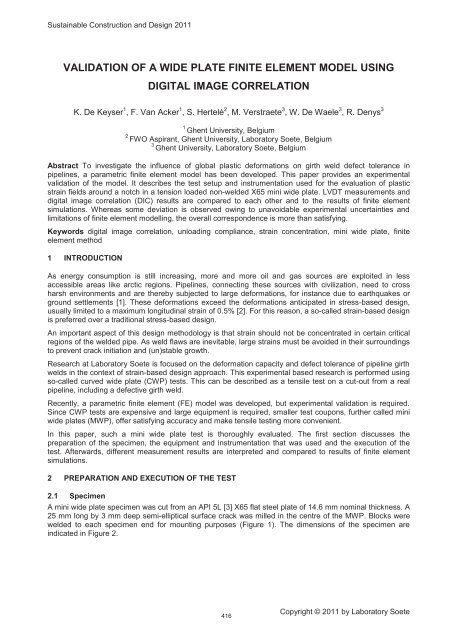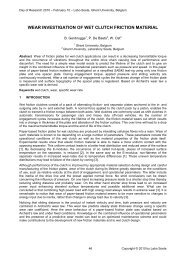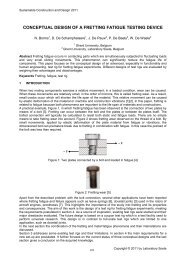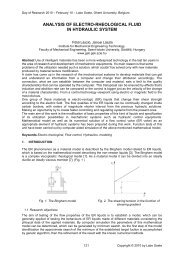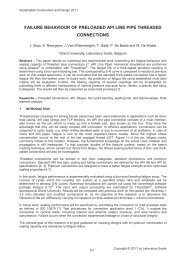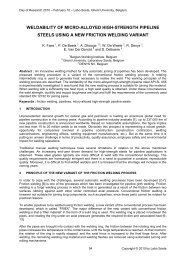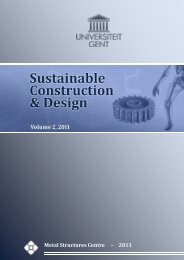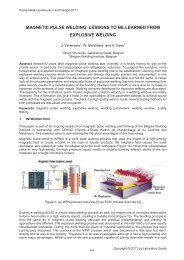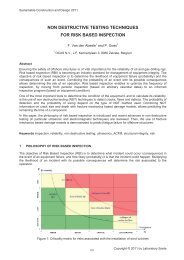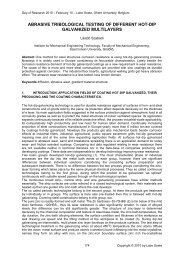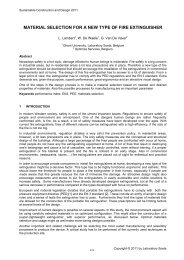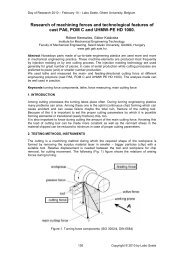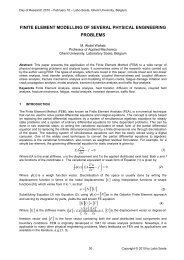validation of a wide plate finite element model using digital image ...
validation of a wide plate finite element model using digital image ...
validation of a wide plate finite element model using digital image ...
You also want an ePaper? Increase the reach of your titles
YUMPU automatically turns print PDFs into web optimized ePapers that Google loves.
Sustainable Construction and Design 2011Figure 1: Test specimen with mounting blocks2.2 MaterialThe stress-strain relation (average <strong>of</strong> 6 tensile tests) <strong>of</strong> the pipeline steel in the longitudinal direction isshown in Figure 3. The <strong>plate</strong> material exhibits discontinuous yielding behaviour with a pronounced Lüders<strong>plate</strong>au. The main tensile characteristics are listed in Table 1. Note that the yield-to-tensile stress ratio (Y/Tratio)is defined as the ratio between 0.2% pro<strong>of</strong> stress R p0.2 and ultimate tensile stress R m .Table 1: Mechanical properties <strong>of</strong> API 5L X65 pipeline steelupper yield point R e 455.0MPa ultimate tensile stress R m 537.4 MPapro<strong>of</strong> stress R p0.2 433.5 MPa uniform elongation e m 16.1%0.5% strain <strong>of</strong>fset R t0.5 433.5 MPa yield-to-tensile ratio R p0.2 /R m 0.83Lüders elongation e Lüders 2.62%Figure 2: Geometry and mounting positions <strong>of</strong>measurement devices (figure not to scale)Figure 3: Longitudinal stress-strain curve <strong>of</strong> thematerialFor optical strain measurements, a randomly distributed speckle pattern was applied on the notched side <strong>of</strong>the specimen. The speckle pattern was obtained from a uniform layer <strong>of</strong> white spraying paint covered withspots <strong>of</strong> black lacquer paint. This pattern allows the Digital Image Correlation (DIC) camera system to trackdifferent regions <strong>of</strong> the MWP during the experiment. More information on this system is given in section2.3.3. To avoid crumbling <strong>of</strong> the paint layer during the test, the corrosion layer on the specimen wasremoved in advance.2.3 Test rig and measurement equipment2.3.1 MTS test rigA servo-hydraulic MTS universal test rig was used for this experiment. The system can exert a maximumforce <strong>of</strong> 2500 kN and a maximum piston displacement <strong>of</strong> 150mm.417Copyright © 2011 by Laboratory Soete
Sustainable Construction and Design 20112.3.2 LVDTs and clip gaugeTo measure the deformation at different locations <strong>of</strong> the specimen, 4 LVDTs were mounted on the backside<strong>of</strong> the specimen according to the UGent guidelines for CWP testing [4]. Two <strong>of</strong> them with gauge length 108mm (K1 and K2) were located in the gross section <strong>of</strong> the specimen, away from the notch. The two otherLVDTs (G1 and G2), with gauge length 388 mm, measured the elongation <strong>of</strong> the full prismatic section,traversing the defected section. Their position is indicated in Figure 2.A clip gauge was put over the notch to measure the crack mouth opening displacement (CMOD).2.3.3 DIC camera systemDigital Image Correlation (DIC) is an optical method in which the movement <strong>of</strong> speckle dots is tracked tocalculate their displacement. From this displacement, strain fields on the surface <strong>of</strong> the specimen can bedetermined. In this experiment, a setup <strong>of</strong> two cameras is used to allow 3D vision, so out-<strong>of</strong>-planedeformations (eg. necking) <strong>of</strong> the specimen can be evaluated as well. Both cameras are synchronized andtake one picture <strong>of</strong> 5Mpx every 10 seconds. A laptop with control and processing s<strong>of</strong>tware also recordedthe analogous force signal to allow for synchronization <strong>of</strong> the DIC and LabVIEW measurements.A crucial <strong>element</strong> in the DIC technique is the size <strong>of</strong> the speckle dots. Dots should not be too small for thecameras to detect them. If they are too large, however, calculation accuracy is reduced. The specklepattern shown in Figure 4 and Figure 5 did not introduce any correlation issues. The strain resolution was <strong>of</strong>the magnitude 0.1% strain.Figure 4: View <strong>of</strong> speckle pattern on half <strong>of</strong> theMWP specimenFigure 5: Detailed view <strong>of</strong> Figure 4.2.4 S<strong>of</strong>twareA LabVIEW program was developed to control the test rig. The s<strong>of</strong>tware defines whether the test rig shouldload or unload the specimen or hold it in a fixed position, based upon measurements <strong>of</strong> CMOD and appliedforce. In fact, a simple tensile test would suffice to validate the FEM <strong>model</strong>, but it was opted to follow theunloading compliance method [5]. Unloading compliance is a technique whereby the specimen issequentially loaded and unloaded, first in the elastic region, then in the plastic region. In the latter case, theunloading decision is based on a constant increment <strong>of</strong> CMOD. When plotting applied force as a function <strong>of</strong>CMOD, as in Figure 6, different loading and unloading cycles can be seen. From the slope evolution <strong>of</strong> theunloading and reloading cycles, crack size can be determined.418Copyright © 2011 by Laboratory Soete
Sustainable Construction and Design 2011Figure 6: Force with respect to CMODThe s<strong>of</strong>tware provides a parametric input <strong>of</strong> characteristics related to the unloading compliance cycles, forinstance the required CMOD increment between two cycles. When the program is started, it runs through astate diagram, defining different cases <strong>of</strong> how the controller should behave. Depending on the obtainedforce or CMOD, the s<strong>of</strong>tware deliberately switches between cases. When detecting failure, all casedecisions are overruled by a safety mechanism and the test specimen is unloaded. The use <strong>of</strong> a statediagram makes the s<strong>of</strong>tware robust as decisions are not influenced by irrelevant measurements.All LVDT displacements, CMOD, force and piston displacement have been monitored in the LabVIEWs<strong>of</strong>tware and logged into a database at a rate <strong>of</strong> 10 Hz.2.5 Execution <strong>of</strong> the testNo significant problems were recorded except for some temporary malfunctioning <strong>of</strong> the hydraulic valves,which caused an oscillating force (see Figure 6 around 1.3 mm CMOD). Because <strong>of</strong> a too small CMODincrement setting, as much as 85 cycles were executed. Eventually, it was chosen to end the test whenCMOD started increasing drastically, announcing a necking phenomenon in the defective section (netsection collapse). A maximum piston displacement <strong>of</strong> 77.6 mm and force <strong>of</strong> 1215 kN were measured. TheCMOD eventually obtained was 4.8 mm.2.6 Post-mortem analysisAfter testing the specimen, a macro section <strong>of</strong> the notch region was cut out (Figure 7). This sectionindicates a stable crack extension <strong>of</strong> 2 mm in the through-thickness direction, and confirms necking in thedefective section.Figure 7: Macro section <strong>of</strong> the notch419Copyright © 2011 by Laboratory Soete
Sustainable Construction and Design 20113 FINITE ELEMENT MODELA parametric <strong>finite</strong> <strong>element</strong> <strong>model</strong> <strong>of</strong> a curved <strong>wide</strong> <strong>plate</strong> has been previously developed at LaboratorySoete. Mesh density was defined according to an existing mesh convergence study. This resulted in themesh shown in Figure 8 and Figure 9. Clamped boundary conditions were imposed at the end nodes <strong>of</strong> tworigid blocks, attached to the actual <strong>wide</strong> <strong>plate</strong> specimen.The stress-strain curve before necking was converted from engineering values to true stress and truestrain. For the curve after necking, the approach recommended in [6] was followed. This method calculatesa weighted-average <strong>of</strong> an upper and lower bound. The upper bound is a linear extrapolation, the lowerbound a power law extrapolation. A weight factor between the two curves should be iteratively defined tomatch experimental results, and was chosen 0.5 in this case.Figure 8: Global FE <strong>model</strong> (geometry and mesh) <strong>of</strong> the specimenFigure 9: Detailed view <strong>of</strong> themesh at the notch region4 DISCUSSION4.1 Comparison <strong>of</strong> DIC and LVDT measurementsTo validate the strain field calculations by the DIC s<strong>of</strong>tware, engineering strain was compared with thestrain calculated from the LVDT elongation measurements. Because both datasets described the sameexperiment, displacement <strong>of</strong> the pistons was chosen as the common basis for the comparison. The plots inFigure 10 and Figure 11 display the engineering strain measured at the two small LVDTs, K1 and K2.Figure 10: Engineering strain calculated by DIC andmeasured by LVDT K1Figure 11: Engineering strain calculated by DIC andmeasured by LVDT K2When the piston displacement reached about 45 mm, the boundaries <strong>of</strong> the LVDTs linear operation rangewere exceeded, so comparison is limited to this area. The small ripples visible on the curves are caused bythe unloading compliance cycles. It can be seen that both strain measurements are in (very) goodagreement. The correspondence with the large LVDTs (G1 and G2), which did not saturate, is excellent(Figure 12 and Figure 13). The small “hooks” at the right top corner indicate unloading at the end <strong>of</strong> thetest.420Copyright © 2011 by Laboratory Soete
Sustainable Construction and Design 2011Figure 12: Engineering strain calculated by DIC andmeasured by LabVIEW at LVDT G1Figure 13: Engineering strain calculated by DIC andmeasured by LabVIEW at LVDT G2A detailed view <strong>of</strong> the K1 and K2 engineering strains at both sides <strong>of</strong> the notch is shown in Figure 14. Thelarge increments <strong>of</strong> the strain calculated from both LVDT measurements are caused by the Lüdersbehaviour <strong>of</strong> the material. The first region experiencing Lüders behaviour is the K2 region. Roughlybetween 1000 seconds and 1250 seconds, the material at the K2 side yields while the strain at the K1region remains constant. From 2750 seconds to 3000 seconds, the behaviour is opposite. In the intervalbetween these periods, the region around the crack yields. Although this is a small region, it took a longtime before the Lüders yielding ended due to a large number <strong>of</strong> unloading cycles. If the material around thecrack is yielding, a CMOD increment is easily obtained, ca<strong>using</strong> the system to hold, unload, hold and loadagain. The CMOD curve in Figure 14 illustrates this behaviour. CMOD increases in steps when the materialaround the crack is yielding, while remaining constant when the K2 and K1 zones yield.Figure 14: Detailed view <strong>of</strong> Lüders behaviour at both sides <strong>of</strong> the specimen4.2 Comparison <strong>of</strong> FEM results with DIC measurementsComparison <strong>of</strong> the numerical and experimental results is far from straightforward. First, the experimentfollowed the unloading compliance procedure with loading and unloading cycles, while ABAQUS simulatesa monotonically increasing tensile load. Second, the <strong>finite</strong> <strong>element</strong> <strong>model</strong> predicted symmetrical resultswhile small natural variations in material and geometrical properties caused an asymmetrical Lüdersyielding. Third, the specimen’s mounting blocks elastically deform during the test while <strong>model</strong>led as rigidblocks in ABAQUS. Due to this and initial backlash in the test rig, a comparison based on total (piston)displacement is not possible. Fourth, crack growth, and subsequent influence on the strain fields, was not<strong>model</strong>led in ABAQUS. Because <strong>of</strong> these reasons, the engineering strain fields <strong>of</strong> the simulation werecompared to those <strong>of</strong> the DIC measurement at frames corresponding to a fixed and limited LVDT strain,more specifically the frames corresponding to LVDT strains ε K1 <strong>of</strong> 4% and 7%. With these values, theLüders behaviour is avoided and the ductile crack extension can be assumed negligible.Inspection <strong>of</strong> the contour plots <strong>of</strong> the first principle strain (Figure 15 and Figure 16) yields a good agreement(both qualitative and quantitative) between the calculated and measured results. It should be noted thatABAQUS plots logarithmic strain while the DIC-s<strong>of</strong>tware plots Lagrange strain. However, the differencebetween both is small. An expected X-shaped strain concentration around the notch is visible on both plots.Figure 17 and Figure 18 are plots <strong>of</strong> the strain values along the paths defined in Figure 15 and Figure 16.ABAQUS successfully predicted strain hotspots in front <strong>of</strong> the shoulders, which may harm the capability <strong>of</strong>LVDT measurements to indicate a far-field uniform strain. In the experiment, the hotspot at the right side <strong>of</strong>the notch was more pronounced than the left one. ABAQUS overestimates this hotspot in Figure 17,421Copyright © 2011 by Laboratory Soete
Sustainable Construction and Design 2011whereas it is underestimated in Figure 18. This indicates that the experiment is prone to inevitablecoincidences and natural effects which are not (or even cannot be) accounted for in the simulation.Nevertheless, a more than satisfactory overall agreement is observed between the experimental and thesimulated results.Figure 15: First principal strain for ε K1 = 4%Figure 16: First principal strain for ε K1 = 7%Figure 17: First principal strain along path forε K1 = 4%Figure 18: First principal strain along path forε K1 = 7%422Copyright © 2011 by Laboratory Soete
Sustainable Construction and Design 20115 CONCLUSIONSThe optical strain measurement (DIC) results show good accordance with the LVDT measurement results.Although comparison on the small LVDTs was limited to a maximum strain <strong>of</strong> 8%, there seems to be a verygood similarity between the measurements. The major advantage <strong>of</strong> the DIC system is that it providesstrain field output <strong>of</strong> the whole surface <strong>of</strong> the specimen. A disadvantage is the time-consuming andsensitive procedure required to speckle the specimen.The ABAQUS <strong>finite</strong> <strong>element</strong> <strong>model</strong> predicts the MWP’s strain fields fairly well for strains higher than themaximum Lüders strain. Further, crack growth is not yet implemented in the <strong>model</strong>, so application <strong>of</strong> thecurrent <strong>model</strong> at large strains, where ductile crack extension has a significant influence, is discouraged aswell.Although no correlation problems were noted, more accurate DIC results might be obtained when anoptimized speckle pattern is applied to the specimen. A study on the influence <strong>of</strong> the speckle size and howto create speckles in a controlled manner is suggested.6 NOMENCLATUREDICCMODCWPLVDTMWPUCDigital Image CorrelationCrack Mouth Opening DisplacementCurved Wide PlateLinear Variable Displacement TransducerMini Wide PlateUnloading Compliance7 ACKNOWLEDGEMENTSThe authors would like to acknowledge the support <strong>of</strong> the technical staff <strong>of</strong> Laboratory Soete and theBelgian Welding Institute (Wouter Ost, Hans Van Severen, Julien De Meyer, Johan Van Den Bossche,Philip De Baere) during preparation, mounting, unmounting and post-mortem analysis <strong>of</strong> the performed mini<strong>wide</strong> <strong>plate</strong> test. The authors also acknowledge the financial support <strong>of</strong> the FWO (Research Foundation)Flanders (grants nr. 1.1.880.09N, 1.5.247.08N.00) and the IWT (Agency for innovation by science andtechnology; grant nr. SB-091512).8 REFERENCES[1] J. Rupert, G.Tart, Pipeline geohazards unique to northern climates, Proceedings <strong>of</strong> the 8th InternationalPipeline Conference, Calgary, Alberta, Canada, 2006.[2] W. Mohr, Strain-based design <strong>of</strong> pipelines, October 2003. EWI Report Project No.45892GTH.[3] API 5L, Specification for Line Pipe, 42nd edition, American Petroleum Institute, 2000.[4] R. Denys, A. Lefevre, UGent guidelines for curved <strong>wide</strong> <strong>plate</strong> testing, Proceedings <strong>of</strong> the 5 th PipelineTechnology Conference, Ostend, Belgium, 2009.[5] S. Cravero, C. Ruggieri, Estimation procedure <strong>of</strong> J-resistance curves for SE(T) fracture specimens<strong>using</strong> unloading compliance, Engineering Fracture Mechanics, 74, 2735-2757, 2007.[6] Y.Ling, Uniaxial True Stress-Strain after Necking, AMP Journal <strong>of</strong> Technology, 5, 37-48, 1996.423Copyright © 2011 by Laboratory Soete


